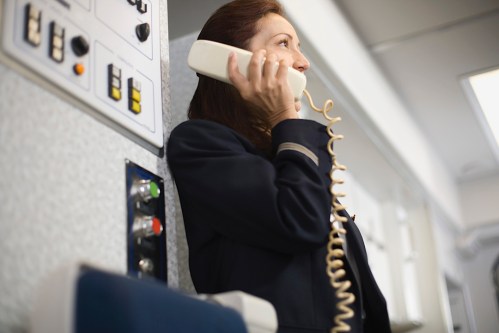Is there a doctor on board? It’s a question no one wants to hear in the air—not the ill passenger, flight crew, other flyers, or responding medical pro. But it does happen, and on a recent flight, surgical oncologist Andrea Merrill, MD, found herself needing to assist a fellow passenger. After landing, she sent a tweet directed at Delta Air Lines that’s now gone viral:
Experts in This Article
Dr. Paulo Alves is the global medical director of aviation health at MedAire, an on-ground medical service that works with 179 airlines, including United, American, and British Airways.
Dear @Delta, I just assisted in a medical emergency in the air. Your medical kits need a glucometer, epi pen, and automatic blood pressure cuffs- it’s impossible to hear with a disposable stethoscope in the air. Please improve this for passenger safety!
A slew of comments followed from physicians who have also assisted in mid-air emergencies (on various airlines, not just Delta) and also found medical kits lacking. In addition to the supplies above, these good samaritans called out other equipment they felt should be on hand for in-flight emergencies like a pulse oximeter (to measure blood oxygen levels), Narcan (nasal spray to treat known or suspected opioid overdoses), and glucagon (a hormone to treat severe low blood sugar). They also wanted some kind of system to flag medical professionals on board before the flight even takes off.
What commercial airline emergency medical kits contain already
Since 1986, all domestic passenger airplanes with at least one flight attendant have been required to keep an emergency medical kit (EMK) containing drugs and urgent care devices on board. The Federal Aviation Administration (FAA) regulates what goes inside those kits, as well as a minimum level of training for flight crews. The FAA’s required list includes around two dozen items, including CPR masks, IV tubing, a stethoscope, though not necessarily a non-disposable one, an automated external defibrillator (AED), medicines including heart medication atropine, lidocaine (an anesthetic), and nitroglycerin (for chest pain). The kit also includes basic instructions for each drug.
Currently, EMKs are not required to have an EpiPen, they do contain epinephrine, the drug that’s in EpiPens to treat severe allergic reactions. However, only the ampule form is mandatory, rather than the auto-injector pen Dr. Merrill asked Delta to start carrying. This swap is an example of how updating in-flight medical kits with more efficient emergency treatments—like an EpiPen vs. ampules of epinephrine that then need to be manually put into syringes prior to injection—could save valuable time in life-threatening situations.
Why updating in-flight emergency medical kits is complicated
While Dr. Merrill’s tweet’s brought new attention to the issue of in-flight emergency medical kits. The debate around what should be required in those EMKs is a topic that’s been contentious since their creation, according to Paulo Alves, MD, a member of the International Airlines Medical Association and a former chairman of the Air Transport Medicine Committee for the Aerospace Medical Association. He sees both sides.
“We don’t want commercial airplanes to become hospitals,” he says because EMKs and AEDs are considered “no-go items,” meaning a plane wouldn’t be able to take off if any part of them was missing so increasing the required items could pose issues if there are drug shortages or supply chain issues.
Additionally, requiring medications with heavy restrictions, such as a narcotic used to treat seizures, is extremely complex. And Dr. Alves points out that there are still situations where it’s best to land the plane so the ill passenger can get full medical attention. Though these scenarios are very rare, occurring only about two percent of the time, he says.
That being said, Dr. Alves does think the kits should keep evolving, and at a faster rate than they have been. “There’s definitely room for improvement in the kit as it is today,” he says. “The last time they were updated, I don’t think smartphones existed!”
Stressed About The Cost of Holiday Travel? Amazon Could Fly You Home for Just $25 (Yes, Really)

Young Travelers Are Embracing ‘Glowbirding’ to Escape Winter Blues—Here’s Exactly How (and Where) to Do It, Too

‘I’m a Longevity Doctor, and Visiting This Island Changed My Perspective on What Longevity Means’

We reached out to the FAA to ask if any plans to update the kits are underway and received this statement:
“We last updated emergency medical kit requirements in 2004. Currently, the FAA is reviewing the medical kit requirements based on recommendations from the Aerospace Medical Association (AsMA) and has issued guidance with recommendations of additional items to include.”
But as Dr. Alves notes, the FAA requirements are only the bare minimum. “Any airline can go above and beyond,” he says. “We tell all the airlines we work with to include auto-injectors [EpiPens]. And though they’re not required, we also recommend Narcan and automatic blood pressure cuffs.” He also says that any traveler with known allergies should always carry an EpiPen in their carry-on luggage, regardless of what’s in an airline’s EMK.
How flight crews deal with medical emergencies when there’s no doctor on board
Fortunately for flyers, airlines are not solely dependent on doctors being on board to address in-flight medical emergencies. All commercial airlines in the U.S. work with an on-ground medical service of dedicated physicians available at all hours to assist flight crews with emergencies that happen in the skies, according to Dr. Alves, who’s currently the global medical director of Aviation Health for MedAire, an on-ground medical service that works with 179 airlines, including United, American, and British Airways. (Delta works with a similar service, Stat-MD.)
“We estimate that in around 70 percent of cases there’s a physician on board,” says Dr. Alves. “But this includes specialties that may not be as comfortable in an emergency, like dermatologists, pathologists, and psychiatrists.” He likens looking for a doctor on the flight to having a fire break out in a hotel and asking the guests if anyone’s a firefighter. And while he’s grateful for any medical volunteers who heroically step forward to help—he estimates he’s done so a couple of dozen times—“that’s not the way it should work!” he says.
Currently, the FAA does not regulate who can help in an in-flight emergency; they leave it up to each flight crew to decide, but Dr. Alves feels like there’s room for improvement here as well. “Airlines need a professional solution that exists for 100 percent of the situations, and that’s where we come in,” he says.
So what came out of that viral tweet?
As for Dr. Merrill’s message, it turns out you don’t have to work for the FAA to make a change. A little passenger pressure moves the needle… or the stethoscope, in this case. We asked Delta about the viral tweet and a representative returned a statement saying they’ve committed to adding medical-grade stethoscopes, automated blood pressure cuffs, and pulse oximeters to all EMKs on their commercial flights.
“This is just the start,” the statement from Delta reads, “because as medical technologies advance, we can, too.” The sky is truly the limit.
Sign Up for Our Daily Newsletter
Get all the latest in wellness, trends, food, fitness, beauty, and more delivered right to your inbox.
Got it, you've been added to our email list.








